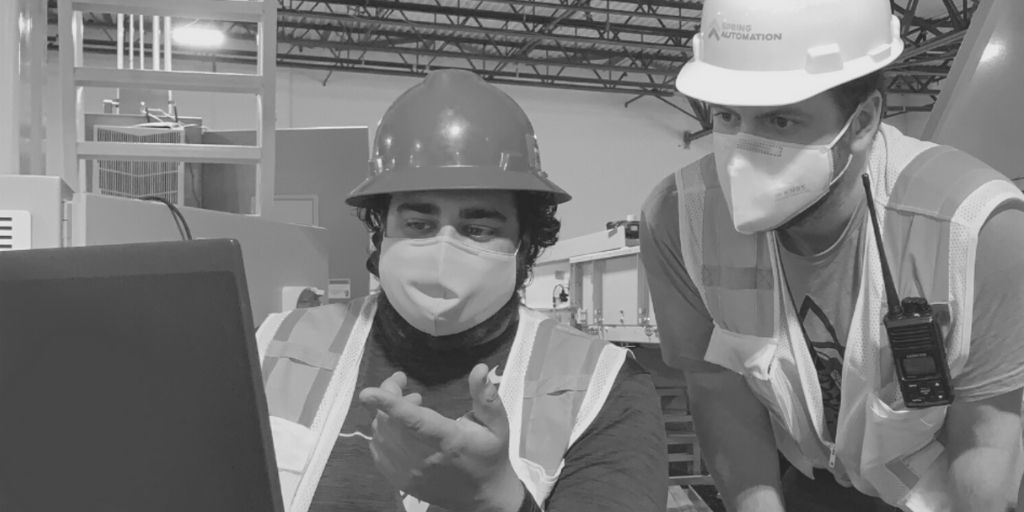"An investment in knowledge always pays the best interest.” -Benjamin Franklin
At Spring Automation, we value team success and challenge every individual to strive for professional development. Training can help an employee feel more confident in his or her role producing better performance and efficiency. Nash Orten, a Spring Automation Engineering Team Lead, created a training portal to pave the road for growth by providing straightforward and easy to access training documents for all team members. His goal for the training portal design included ease of access, low pressure for trainees, and crafting a roadmap of content that matters. We are committed to providing employees the tools needed to succeed. Here are seven reasons to invest in training and other goals when creating the Spring Automation training portal.
7 Reasons to Invest in Training and Onboarding:
1. Set the Tone. Organized and developed training sets the tone for new hires; it shows them the company they just joined is organized and invested in their professional growth.
2. Hit the Ground Running. Proper training allows a recruit to spend two to four weeks preparing themselves for various engineering work, allowing them to impact project work within a month. Traditionally it takes a person three to five months to be effective.
3. Understand the Product. Good training can teach you how to do a task. Excellent training teaches you where your efforts fall into the bigger picture: the final product. Great training starts with driving the big picture of these systems home to the recruit.
4. Expand Hiring Pool. When a company invests in training programs, it now has the benefit of expanding its hiring pool to more entry-level talent. This is beneficial for candidates fresh out of school, providing more opportunities for students, and the business has more candidates and lower overhead.
5. Reduce Onboarding Strain. Training that is strategically planned can reduce the time spent by senior staff getting a recruit up to speed. Most training can be completed well before the "mentorship" phase starts, ensuring the recruit trains efficiently under a senior member.
6. Continued Growth. Training isn't just for new hires; continued growth and professional development is a vital part of staying ahead of the curve in today's technically challenging environment as well as keeping current team members engaged. When members have access to continuous training efforts, both employees and administrators can set constant improvement goals that are measurable and beneficial.
7. Team Engagement. Training and onboarding is a team effort, with members contributing and taking ownership of various content. This gives our more experienced team members the chance to share their knowledge and give back to the community within Spring.
Training Portal Design Goals:
1. Low Pressure & Ease of Access. Ensuring the training material is in a format that is easy to follow and readily accessible ensures that new hires can train at their own pace. This results in trainees taking the appropriate time to learn a new skill or freshen up on existing skills at their own pace.
2. Archive of Knowledge. Previously, it was required for an individual to be involved in a project to reap the experience gained during the process. Now, experienced team members can share their experience and knowledge with others by developing "training modules." This allows a new and existing member to navigate the various modules available, picking up skills and insights previously unavailable.
3. Content That Matters. Providing visual aids and working examples helps new hires retain key processes while feeling comfortable tackling real project work for the first time. With ever-changing technical/client specifications, Spring ensures that critical concepts are showcased, cutting down on time spent "searching for answers."
4. Road-mapping. The process of developing a training "map" that allows a new hire to hyper-focus the subjects they will be working on initially. With all the technical disciplines of our industry, road-mapping allows Spring to model various training efforts to fit our project forecasts, ensuring we have the resources available when and where they are needed most.
5. Remote Capabilities. The Training Portal was designed to onboard team members from home with remote work in mind. It is rarely necessary for a team member to be somewhere in person when using the latest technology and a remote mentality. This allows for flexible training times and opens Spring up to hiring individuals outside of the Nashville area.
6. Virtual Tours. Want to catch up on a previous project or learn about specific systems? Why not take a tour of a facility before diving into working examples that showcase how to design the system? Through our 360-degree view virtual tours, it is now possible to showcase our product to someone entirely new to our industry.
Are you looking for an opportunity to grow in a collaborative and team-oriented environment? Connect with us at careers@springautomation to learn more about employment opportunities.

